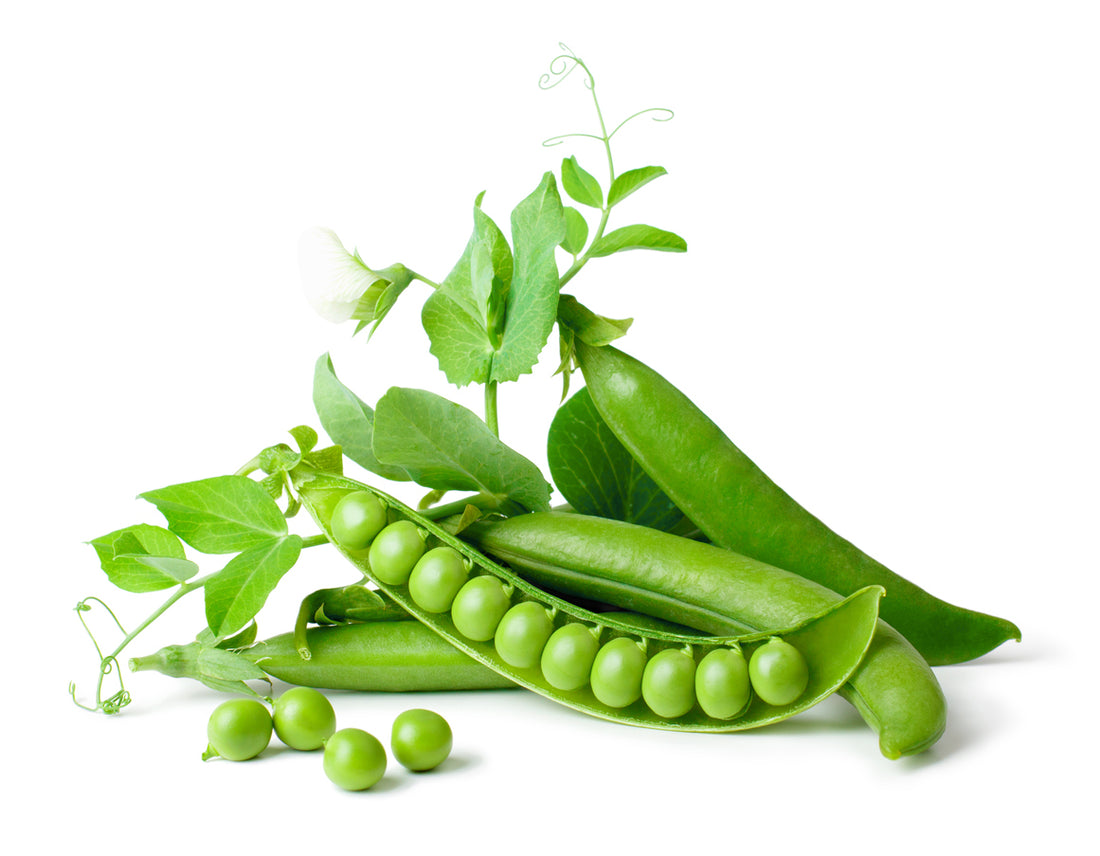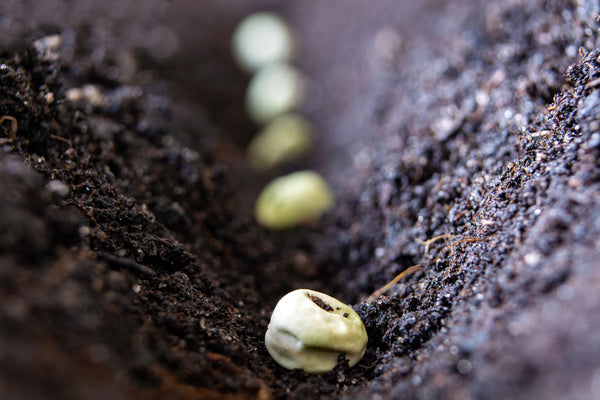Whether you're a seasoned gardener or just starting, peas are a versatile crop that deserves a spot in your garden. Their bright green pods bring life to any garden bed, and their delicious taste complements countless dishes. Here's your ultimate guide to mastering the art of cultivating peas.
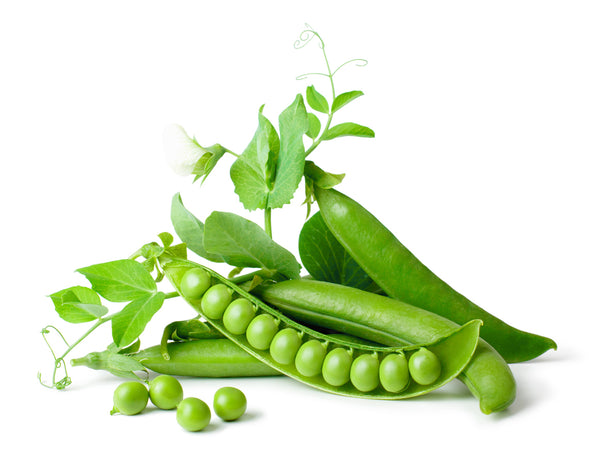
The Ultimate Guide to Mastering The Art Of Cultivating Peas
For those who cherish garden-to-table freshness, peas are an invaluable addition. They're delightful to grow and delicious to eat. Peas are not just a versatile culinary delight; their adaptability makes them a favourite among garden owners and urban balcony gardeners.
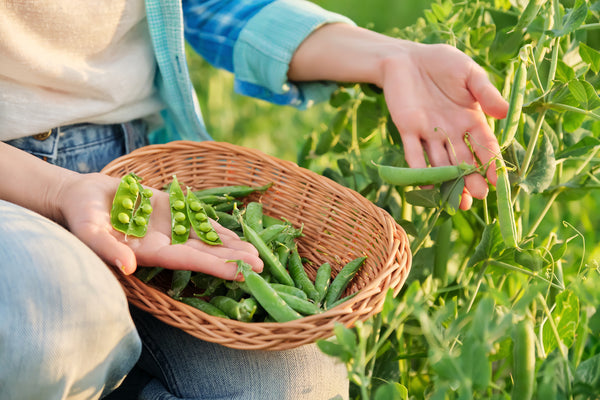
Pea Varieties and Their Uses
Choosing the correct type of pea for your garden is essential for both cultivation and culinary enjoyment. Whether you're interested in traditional garden peas, flat and edible-podded snow peas, or the crunchy snap peas that are perfect for snacking, understanding the characteristics of each type will help you make an informed decision. The table below provides an overview of each type, offers suggestions for varieties to consider, and outlines their best culinary applications. Let this guide help you pick the perfect pea for your palate and garden!
| Type | Description | Suggested Varieties | Culinary Uses |
| Garden (Green) Peas | Peas are taken from their pods. | Greenfeast (Dwarf), Utrillo (Climbing), Alderman Tall (Climbing) | Salads, side dishes, soups |
| Snow Peas | Flat, delicate pods with tiny peas inside. The entire pod is eaten. | Shiraz, Goliath, Kennedy Dwarf, Carouby | Stir fries, salads |
| Snap Peas | Combines garden and snow peas. These are eaten whole, including the pod. | Sugar Snap, Dwarf Sugar Snap | Snacks, salads, sauteed dishes |

Pea Greenfeast is a dwarf pea. These are seedlings transplanted into raised garden beds and planted in a single line with supportive twine.
Side Note: What Does 'MangeTout' Mean?
Sugar Snap peas and Snow Peas are often called "mangetout," a French term that translates to "eat all" in English. The name "mangetout" aptly describes these types of peas since the entire pod is edible—both the peas and the pod itself. However, it's worth noting that there are subtle differences between the two, both in terms of their physical characteristics and culinary applications:
Snow Peas: These have flat, edible pods and are usually harvested before the peas inside develop to a large size. They are often used in stir-fries or salads.
Sugar Snap Peas: These cross between snow peas and garden peas. The pods are plumper compared to snow peas and are also entirely edible. They are sweet and crunchy and can be eaten raw or cooked.
Although both can be referred to as "mangetout," specifying Snow Peas or Sugar Snap Peas when discussing or cooking can be beneficial to distinguish between their distinct textures and flavours.
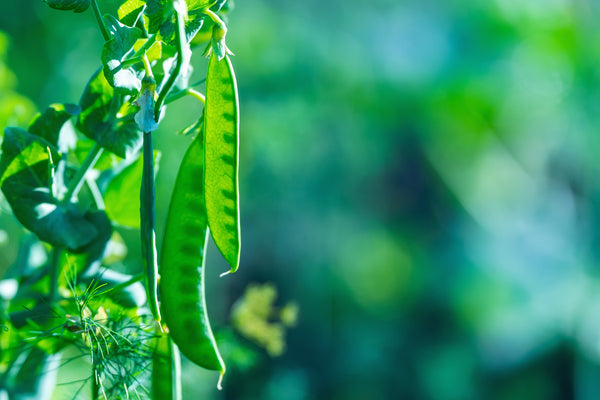
These Sugar Snap Peas are ready to be picked and eaten. These are defined as 'mangetout', which means the entire pod is eaten and enjoyed. Yum!
Sowing & Growing Peas: Indoors and Outdoors
When?
Indoors: The best time to start sowing peas indoors is about 4-6 weeks before your area's last expected frost date. You can read a detailed explanation of this concept later in this article.
Outdoors: Direct sowing outdoors can begin in spring, after your area's last frost and when the soil is easy to cultivate.
Why?
Indoors: Starting peas indoors gives them a head start on the ones sown outside, which can result in an earlier harvest.
Outdoors: Peas thrive in cooler weather, so sowing outdoors, on the other hand, can provide a longer harvesting window and reduce transplanting stress.
How?
Indoors: Use pots or trays with good quality potting mix. Plant seeds 2.5 cm deep (1 inch) and cover lightly with potting mix. Water consistently and provide adequate light. Once they're 2-3 inches tall, harden off and transplant.
Outdoors: Ensure the soil is well-draining. Sow seeds 2.5 cm (1 inch) deep and about 5 cm (2 inches) apart in rows. Once the seedlings have sprouted, thin them to about 10-15 cm (4-6 inches) apart.
Did you know? Peas naturally enrich the soil, making it fertile and ready for subsequent crops.
Growing Peas on a Balcony
For those without a garden, balconies can serve as an ideal space for pea cultivation. Here are a few tips for success:
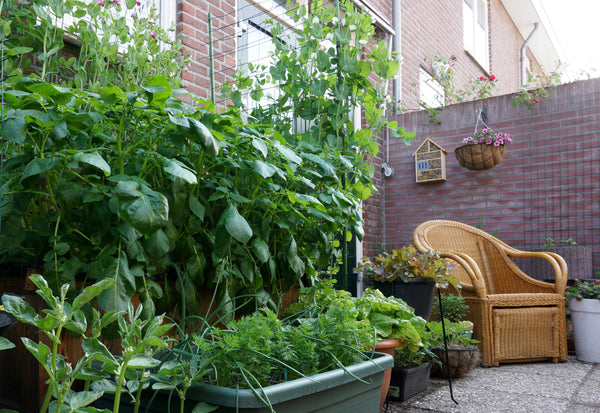
Choosing Containers: Opt for pots or containers at least 25 cm (10 inches) deep. Ensure they have drainage holes.
Soil Selection: Use a high-quality potting mix, ensuring it remains moist but not soggy.
Placement: Peas need at least 5-6 hours of direct sunlight. Position your containers in the sunniest spot on your balcony.
Support: Even in pots, peas need support. Use small trellises or sticks to guide their growth upwards.
Watering: Containers dry out faster. Check the soil moisture regularly and water as necessary.
The Benefits of Root Trainers
If you want to get professional about it, root trainers or specially designed pots with grooved sides offer an ideal solution for pea seedlings.
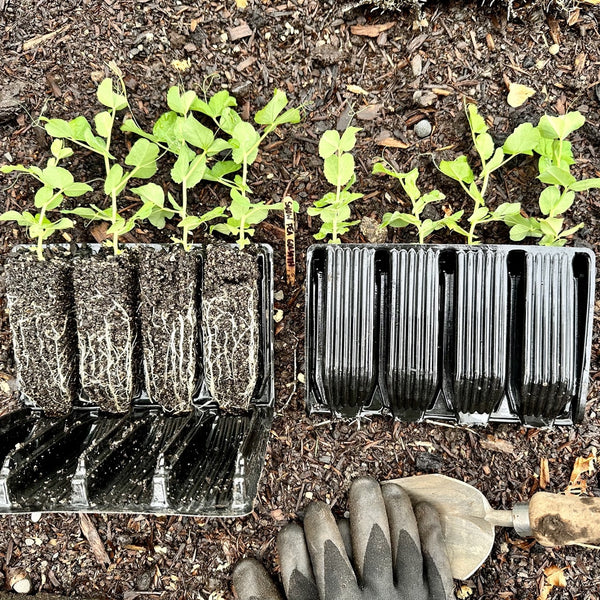
Root trainers are used for raising peas. On the right are the unopened trainers, and on the left are the opened ones, ready for transplanting into the garden.
Root trainers offer these advantages over traditional pots:
Deep Cells: Drives root growth downward, which benefits peas.
Air Pruning: The design deters roots from spiralling, fostering a more robust root system.
Effortless Transplant: The opening system limits root disturbance, streamlining transplanting.
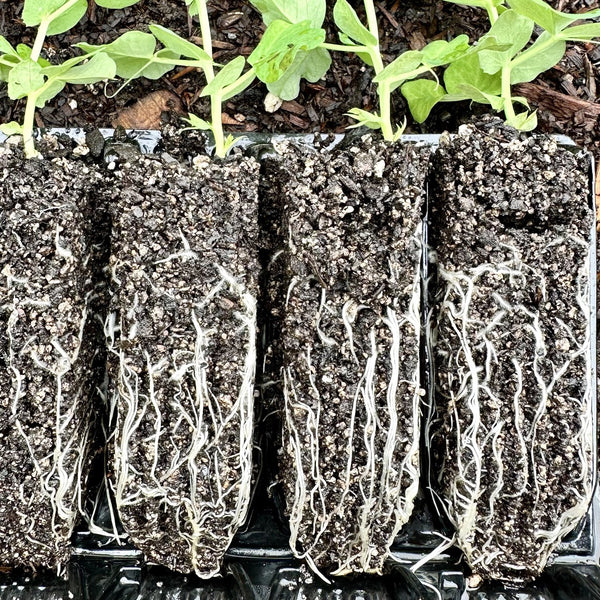
As the photo above illustrates, the deep cells of root trainers drive root growth downward, which benefits peas.
The Scoop on Sowing Peas in Used Toilet Rolls
So, root trainers may be a step too far for you. However you might have heard about the gardening hack of using empty toilet rolls as seed starters, but have you ever wondered why this method is particularly beneficial for peas? Here's the lowdown:
Biodegradable
Toilet paper rolls are made from paper, making them biodegradable. When it's time to transplant your peas, you can plant them directly into the ground in their toilet roll containers. This method avoids disturbing the roots, and the paper will decompose naturally over time.

Deep Roots
Peas love to send their roots deep into the soil. The length of a toilet paper roll provides more depth than a traditional seed tray, allowing for a healthier, more robust root system.
Moisture Control
The cardboard absorbs excess moisture, reducing the risk of root rot while ensuring the soil stays moist.
Sustainability
Using toilet paper rolls is a great way to recycle and reduce waste, making your gardening efforts even more eco-friendly.
Cost-Effective
Why invest in specialised seed-starting kits when you have a cost-effective solution in your recycling bin?
This simple, ingenious trick can enhance your pea-growing experience while embracing sustainable gardening practices. Give it a try!
Helpful Hint: Crumple a small piece of paper and push it into one end of the toilet roll to stop the potting mix from falling out.
Why Do I Need to Time My Indoor Seed Sowing Around the Last Expected Frost Date?
The guideline to start sowing peas indoors about 4-6 weeks before the last expected frost date is based on several factors related to the pea plant's natural growth cycle and environmental requirements. Here's why this timeframe is often considered optimal:
Early Harvest
Starting peas indoors gives you a head start on the growing season. When you transplant these early starters to the outdoors, they are already partially grown, giving you a jump on harvesting before the hot weather sets in.
Frost Sensitivity
While pea plants are cool-weather crops, the seedlings are more sensitive to frost than mature plants. Starting them indoors allows the plants to establish themselves in a controlled environment before being exposed to outdoor elements.
Soil Temperatures
Peas prefer to germinate in cool but not frozen soil. Sowing indoors allows you to control the temperature more efficiently, ensuring optimal germination rates.
Maximising Cool-Weather Growth
Peas thrive in cool weather and can struggle as temperatures rise. Getting an early start means harvesting before the hottest parts of summer, where high temperatures could reduce yield and quality.
Pest and Disease Avoidance
Starting indoors can reduce the risk of soil-borne diseases and pest attacks, giving the plant a stronger start.

I purchased this cute pea sign at Bunnings for only $1.50!
What Are The Best Soil Conditions For Growing Peas?
The soil condition plays a critical role in successfully cultivating pea plants. Here are some factors that contribute to ideal soil conditions for growing peas:
Soil Type
Soil Moisture: Peas prefer well-drained, loamy soil that allows good water retention but doesn't become waterlogged. This soil type offers good aeration and drainage while retaining enough plant moisture.
Soil pH: Peas are tolerant regarding soil pH but do best in slightly acidic to neutral soil, with a pH range of 6.0 to 7.0.
Soil Preparation
Organic Matter: Incorporating organic matter like compost or well-rotted manure into the soil can improve its structure, drainage, and nutrient content. Organic matter can help sandy and clay soils become more hospitable for peas.
Fertility: While peas are legumes that can fix nitrogen, they still benefit from moderately fertile soil. A balanced fertiliser low in nitrogen but rich in phosphorus and potassium can be beneficial.
Weed-Free: Removing weeds from the planting area is essential, as they can compete with your pea plants for nutrients and water.
Soil Temperature
Cool but Not Cold: Peas are cool-weather crops that prefer soil temperatures between 45°F (7°C) and 75°F (24°C) for optimal germination. The soil should be workable and not frozen.
Moisture Levels
Consistent Moisture: Peas don't like waterlogged soil but require constant moisture, especially during flowering and pod formation. A well-drained, loamy soil helps maintain this balance.
Paying attention to these factors will create a soil environment where peas can thrive, leading to a healthy plant and a bountiful harvest.
Support and Protection for Your Peas
Growing peas isn't just about sowing seeds and awaiting the harvest; these plants also need physical support and protection against predators to thrive. From traditional trellises to modern netting, the choices are numerous, and the best option depends on the variety of peas and your specific gardening conditions. This section delves into effectively supporting and safeguarding your plants from common threats like birds and rodents.

I support newly planted seedlings using netting wrapped around a metal structure and inserting small twigs into the soil to encourage the pea tendrils upwards.
Best Materials for Supporting Peas
When supporting your peas, several materials can do the job effectively. Here are some options:
Bamboo Stakes: Bamboo is sturdy, lightweight, and eco-friendly. It can easily support the weight of growing pea plants. Being natural, it also blends well with the garden aesthetics.
Plastic Netting: Though not as eco-friendly, plastic netting is durable and low-maintenance. It's handy for taller varieties like snow peas and snap peas, which tend to grow higher.
Twigs and Branches: Using twigs and small branches can work if you're looking for a no-cost option. However, ensure they are sturdy enough to support your plants. This option is more suitable for shorter varieties like garden peas.
Wooden Lattice: A wooden lattice offers functionality and visual appeal, but ensure the wood is untreated to avoid any potential for chemical leaching.
String and Wire: Garden twine or wire can create a grid, especially when combined with stakes or poles.
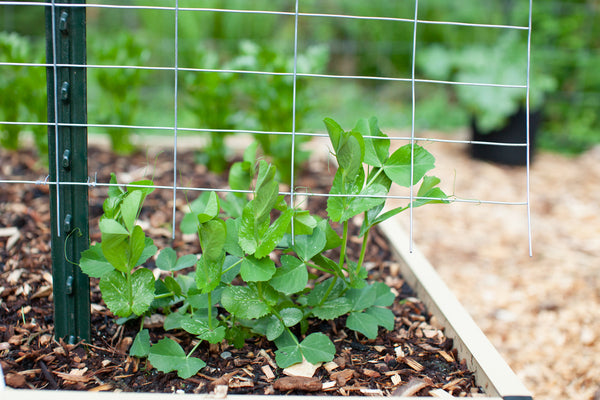
Metal Trellises: These are durable and can last several seasons but may be more expensive initially. They can be used for taller pea varieties.
What Else To Consider When Supporting Pea Plants
Height of the Variety: Taller varieties like snow and snap peas require taller, sturdier supports, while shorter garden peas may do fine with lower supports like twigs.
Environmental Factors: You'll need more robust and stable materials in windy areas. Likewise, if you're planting in pots on a balcony, consider the weight and stability of your chosen support material.
Sustainability: Natural options like bamboo and twigs are biodegradable and can be composted at the end of the season, making them a sustainable choice.
A thoughtful selection of supports and protective measures will ensure that your pea plants grow strong and yield an abundant harvest.
Further Suggestions For Guaranteed Pea Success
Choosing the right location in your garden for planting peas is crucial for ensuring a healthy and abundant harvest. Here are some considerations:
Sunlight Exposure
Sunny Spot: Peas require a minimum of 6-8 hours of direct sunlight daily for optimal growth. However, suppose you're in an area with hot summers. In that case, a location with partial afternoon shade can help the plants tolerate the heat.
Wind and Protection
Wind Protection: While pea plants are relatively sturdy, they can benefit from some protection against strong winds. A spot near a fence or a wall can provide this protection without inhibiting sunlight.
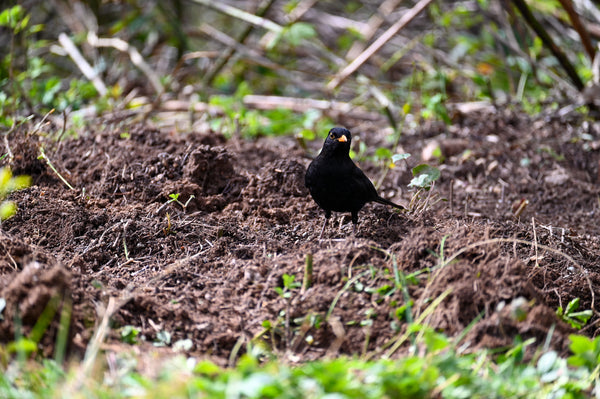
Predators and Pests: Birds can be attracted to freshly sown pea seeds and may dig them up. Using netting can deter them. Snails and slugs also like young pea plants; a natural barrier like crushed eggshells or diatomaceous earth around your plants can help.
Soil Drainage
Well-Drained Area: Make sure the chosen location has well-drained soil. Pooling water can lead to root rot and other fungal diseases. Use raised beds to improve drainage if your garden has heavy clay soil.
Crop Rotation
Previous Plants: It's a good idea to plant peas where nitrogen-consuming plants like corn or tomatoes were grown the last season. Peas fix nitrogen into the soil, benefiting themselves and future plants in that spot.
Accessibility
Easy to Reach: Plant your peas in an easily accessible area for regular care, harvest, and pest management. Also, consider the type of support they'll need (trellis, fence, etc.) and ensure enough space.
Common Pests
Birds: As mentioned, birds may go for the seeds. Using netting or scare tactics like reflective tapes can help.
Snails and Slugs: These pests love munching on young pea plants. Use natural barriers, snail traps, or organic snail bait to control them.
Companion Plants
Friendly Neighbours: Consider companion planting with carrots, radishes, or turnips, which can help deter pests and efficiently use space.
By carefully choosing the location and taking preventive measures against potential issues, you'll set the stage for a fruitful pea-growing season!
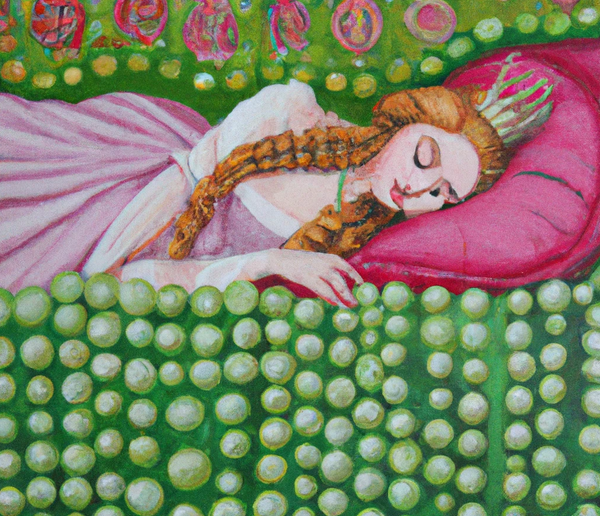
FUN FACT...Did you know, historically, society's elite used peas to stuff their mattresses!
Conclusion
Embracing peas in your garden or on your balcony is a journey filled with green delights, a touch of history, and the joy of cultivation. With a pinch of care and the right environment, you'll soon have a fresh supply of peas to savour. Please sign up to be notified of my upcoming posts. Until then, happy gardening!
---
Stephanie Evans gardens every day at Oasis Cottage, where she demystifies the art of gardening for beginners and experts. She believes in a holistic approach to gardening, where your well-being and garden are symbiotically connected.
Do you have any thoughts or questions about growing peas? I would love to hear from you, so feel free to leave a comment.
